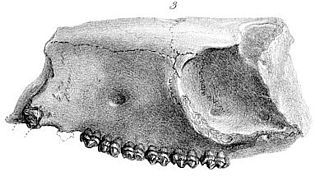
Hyracotherium is an extinct genus of very small perissodactyl ungulates that was found in the London Clay formation. This small, fox-sized animal was once considered to be the earliest known member of Equidae before the type species, H. leporinum, was reclassified as a palaeothere, a perissodactyl family basal to both horses and brontotheres. The remaining species are now thought to belong to different genera, such as Eohippus, which had previously been synonymised with Hyracotherium.

The rock hyrax, also called dassie, Cape hyrax, rock rabbit, and coney, is a medium-sized terrestrial mammal native to Africa and the Middle East. Commonly referred to in South Africa as the dassie, it is one of the five living species of the order Hyracoidea, and the only one in the genus Procavia. Rock hyraxes weigh 4–5 kg (8.8–11.0 lb) and have short ears and tails.

Verreaux's eagle is a large, mostly African, bird of prey. It is also called the black eagle, especially in southern Africa, not to be confused with the Indian black eagle, which lives far to the east in Asia. Verreaux's eagle lives in hilly and mountainous regions of southern and eastern Africa, and very locally in West Africa, the Arabian Peninsula and the southern Middle East. It is one of the most specialized species of accipitrid in the world, with its distribution and life history revolving around its favorite prey species, the rock hyraxes. When hyrax populations decline, the species have been shown to survive with mixed success on other prey, such as small antelopes, gamebirds, hares, monkeys and other assorted vertebrates. Despite a high degree of specialization, Verreaux's eagle has, from a conservation standpoint, been faring relatively well in historic times. One population of this species, in the Matobo Hills of Zimbabwe, is arguably the best studied eagle population in the world, having been subject to continuous detailed study since the late 1950s. Like all eagles, this species belongs to the taxonomic order Accipitriformes and the family Accipitridae, which may be referred to colloquially as accipitrids or raptors.
Hyrax Hill is a prehistoric site near Nakuru in the Rift Valley province of Kenya. It is a rocky spur roughly half a kilometer in length, with an elevation of 1,900 meters above sea level at its summit. The site was first discovered in 1926 by Louis Leakey during excavations at the nearby Nakuru Burial Site, and Mary Leakey conducted the first major excavations between 1937 and 1938. There are two distinct areas of occupation at Hyrax Hill: one which was occupied during the Pastoral Neolithic and late Iron Age, and one which was occupied by the Sirikwa earlier in the Iron Age.
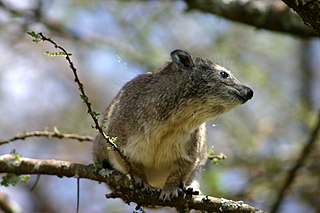
The southern tree hyrax, also known as the southern tree dassie, is a species of mammal in the family Procaviidae. The southern tree hyrax is mainly found in the south central eastern side of Africa.

The tree hyrax or tree dassie is a small nocturnal mammal native to Africa. Distantly related to elephants and sea cows, it comprises the four species in the genus Dendrohyrax, one of only three genera in the family Procaviidae, which is the only living family within the order Hyracoidea.

The western tree hyrax, also called the western tree dassie or Beecroft's tree hyrax, is a species of tree hyrax within the family Procaviidae. It can be distinguished from other hyraxes by short coarse fur, presence of white patch of fur beneath the chin, lack of hair on the rostrum, and lower crowns of the cheek teeth compared to other members of the same genus.

The yellow-spotted rock hyrax or bush hyrax is a species of mammal in the family Procaviidae. It is found in Angola, Botswana, Burundi, the Democratic Republic of the Congo, southern Egypt, Eritrea, Ethiopia, Kenya, Malawi, Mozambique, Rwanda, Somalia, northern South Africa, South Sudan, Sudan, Tanzania, Uganda, Zambia, and Zimbabwe. Its natural habitats are dry savanna and rocky areas. Hyrax comes from the Greek word ὕραξ, or shrew-mouse.
Hyraceum is the petrified and rock-like excrement composed of both urine and feces excreted by the Cape hyrax.
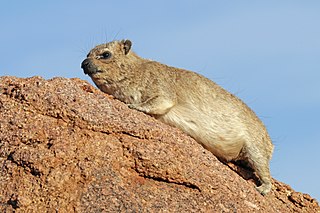
Hyraxes, also called dassies, are small, thickset, herbivorous mammals in the order Hyracoidea. Hyraxes are well-furred, rotund animals with short tails. Typically, they measure between 30 and 70 cm long and weigh between 2 and 5 kg. They are superficially similar to pikas and marmots, but are more closely related to elephants and sea cows.
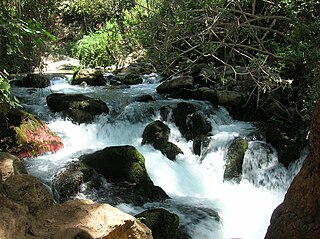
Banias River is a river in the Golan Heights. It is the easternmost of the three main northern tributaries of the Jordan River; together with the Dan River and the Snir Stream, it forms the Jordan River's upper catchment (UCJR). Israel has included the stream in the Hermon nature reserve.

The eastern tree hyrax is a species of mammal within the family Procaviidae. The eastern tree hyrax is the most localized of the tree hyrax species, distributed patchily in a narrow band of lowland and montane forests in Kenya and Tanzania and adjacent islands.
Geniohyus was a genus of herbivorous hyrax-grouped mammal.
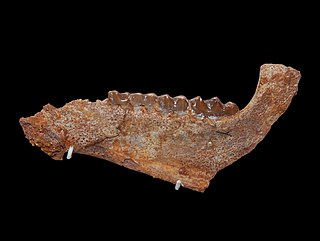
Saghatherium was a genus of herbivorous hyrax that lived during the Oligocene period and what is now in Egypt, Libya and Oman.
Selenohyrax was a genus of herbivorous hyrax-grouped mammal.
Thyrohyrax was a genus of herbivorous hyrax-grouped mammal. It may have been semi-aquatic based on isotopic ratios of its tooth enamel.
Bunohyrax was a genus of herbivorous hyrax-grouped mammal.
Microhyrax was a prehistoric genus of herbivorous hyrax-grouped mammal. It lived during the Eocene period from 55.8 to 40.4 million years ago in modern-day Algeria.
Seggeurius was a genus of herbivorous hyrax-grouped mammal.

The Sirikwa culture was the predominant Kenyan hinterland culture of the Pastoral Iron Age, c.2000 BP. Seen to have developed out of the Elmenteitan culture of the East African Pastoral Neolithic c.3300-1200 BP, it was followed in much of its area by the Kalenjin, Maa, western and central Kenyan communities of the 18th and 19th centuries.













